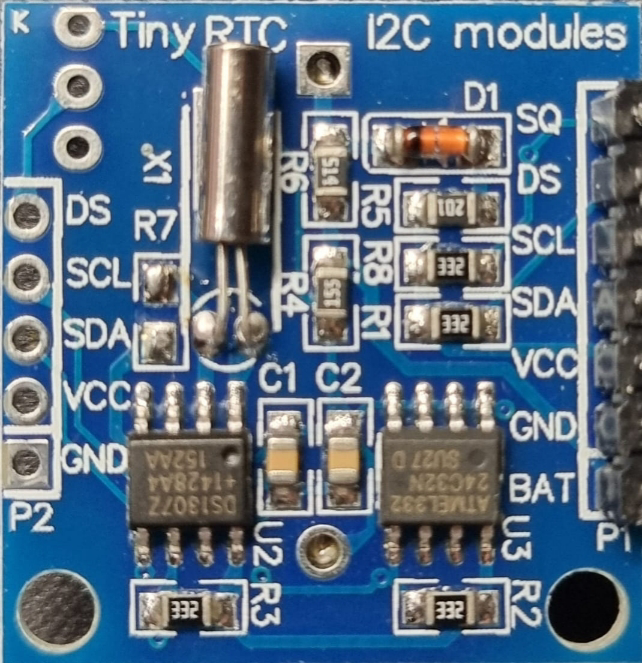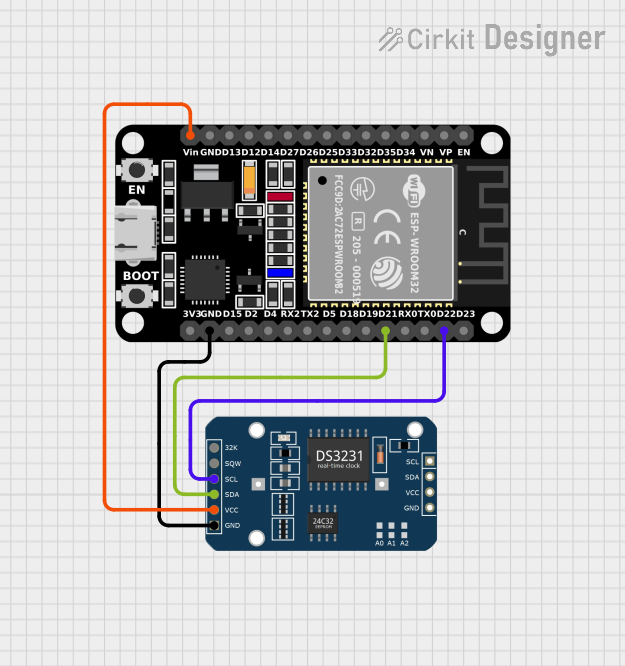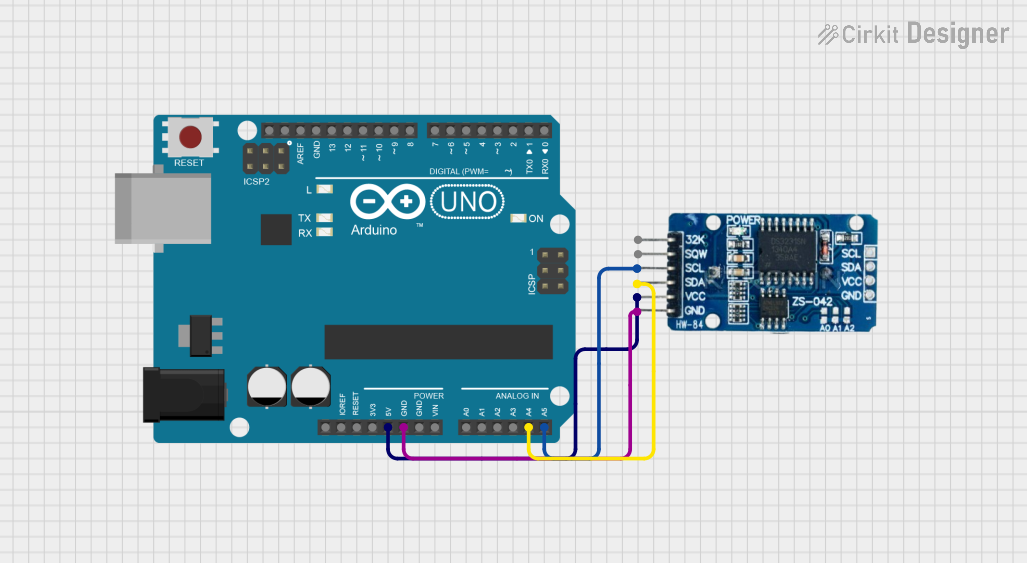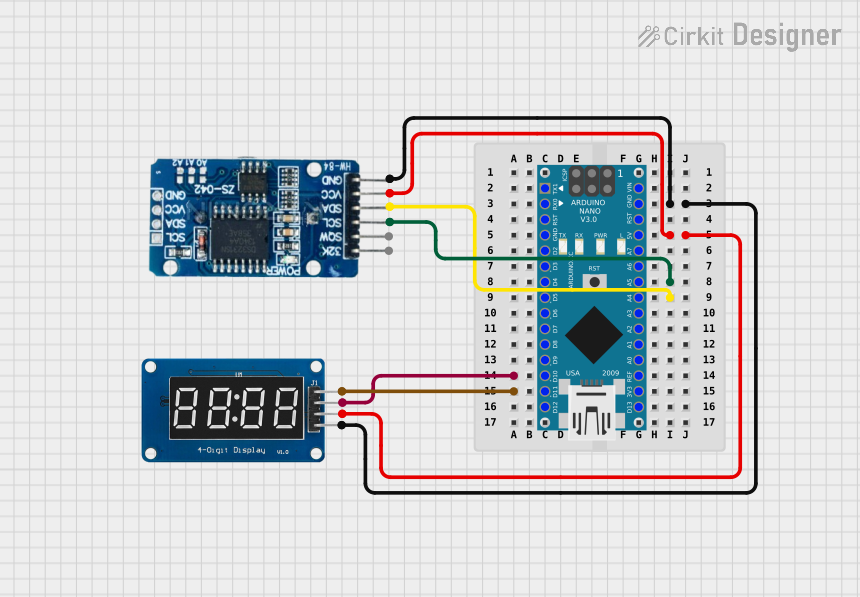
How to Use RTC DS3231: Examples, Pinouts, and Specs

 Design with RTC DS3231 in Cirkit Designer
Design with RTC DS3231 in Cirkit DesignerIntroduction
The DS3231 is a highly accurate real-time clock (RTC) module with an I2C interface. It is designed to keep track of time (hours, minutes, seconds) and date (day, month, year) even during power outages, thanks to its onboard battery backup. The module features a temperature-compensated crystal oscillator (TCXO), ensuring exceptional accuracy with a drift of only ±2 minutes per year.
Explore Projects Built with RTC DS3231

 Open Project in Cirkit Designer
Open Project in Cirkit Designer
 Open Project in Cirkit Designer
Open Project in Cirkit Designer
 Open Project in Cirkit Designer
Open Project in Cirkit Designer
 Open Project in Cirkit Designer
Open Project in Cirkit DesignerExplore Projects Built with RTC DS3231

 Open Project in Cirkit Designer
Open Project in Cirkit Designer
 Open Project in Cirkit Designer
Open Project in Cirkit Designer
 Open Project in Cirkit Designer
Open Project in Cirkit Designer
 Open Project in Cirkit Designer
Open Project in Cirkit DesignerCommon Applications
- Timekeeping in embedded systems
- Data logging with timestamps
- Alarm systems and scheduling
- IoT devices requiring precise time synchronization
- Home automation systems
Technical Specifications
Key Technical Details
- Operating Voltage: 2.3V to 5.5V
- Timekeeping Accuracy: ±2 minutes per year (at 0°C to +40°C)
- Interface: I2C (2-wire)
- Temperature Range: -40°C to +85°C
- Battery Backup: Supports CR2032 coin cell battery
- Oscillator: Built-in temperature-compensated crystal oscillator (TCXO)
- Additional Features:
- Two programmable alarms
- 32kHz output pin
- Temperature sensor with ±3°C accuracy
Pin Configuration and Descriptions
The DS3231 module typically has 6 pins. Below is the pinout and description:
| Pin | Name | Description |
|---|---|---|
| 1 | GND | Ground connection |
| 2 | VCC | Power supply (2.3V to 5.5V) |
| 3 | SDA | Serial Data Line for I2C communication |
| 4 | SCL | Serial Clock Line for I2C communication |
| 5 | 32K | Optional 32kHz output (can be used for external clocking) |
| 6 | SQW | Square Wave/Interrupt output (programmable frequency or alarm interrupt signal) |
Usage Instructions
How to Use the DS3231 in a Circuit
- Power the Module: Connect the
VCCpin to a 3.3V or 5V power source and theGNDpin to ground. - I2C Communication: Connect the
SDAandSCLpins to the corresponding I2C pins on your microcontroller. For an Arduino UNO:SDAconnects to A4SCLconnects to A5
- Optional Connections:
- Use the
SQWpin for alarms or square wave output. - Use the
32Kpin if you need a 32kHz clock signal.
- Use the
- Battery Backup: Insert a CR2032 coin cell battery into the holder to maintain timekeeping during power loss.
Important Considerations
- Ensure pull-up resistors (typically 4.7kΩ) are connected to the
SDAandSCLlines if not already present on the module. - Avoid shorting the battery holder terminals to prevent damage.
- The DS3231 operates on I2C address
0x68by default.
Example Code for Arduino UNO
Below is an example of how to interface the DS3231 with an Arduino UNO to read the current time and date:
#include <Wire.h>
#include "RTClib.h" // Include the Adafruit RTC library
RTC_DS3231 rtc; // Create an RTC object
void setup() {
Serial.begin(9600); // Initialize serial communication
Wire.begin(); // Initialize I2C communication
if (!rtc.begin()) {
Serial.println("Couldn't find RTC. Check connections!");
while (1); // Halt execution if RTC is not found
}
if (rtc.lostPower()) {
Serial.println("RTC lost power, setting the time!");
// Set the RTC to the current date and time
rtc.adjust(DateTime(F(__DATE__), F(__TIME__)));
}
}
void loop() {
DateTime now = rtc.now(); // Get the current time and date
// Print the current time and date to the Serial Monitor
Serial.print(now.year(), DEC);
Serial.print('/');
Serial.print(now.month(), DEC);
Serial.print('/');
Serial.print(now.day(), DEC);
Serial.print(" ");
Serial.print(now.hour(), DEC);
Serial.print(':');
Serial.print(now.minute(), DEC);
Serial.print(':');
Serial.print(now.second(), DEC);
Serial.println();
delay(1000); // Wait for 1 second before updating
}
Best Practices
- Use a fresh CR2032 battery to ensure reliable timekeeping during power outages.
- Avoid exposing the module to extreme temperatures to maintain accuracy.
- Regularly check the battery voltage and replace it when necessary.
Troubleshooting and FAQs
Common Issues and Solutions
RTC Not Detected:
- Cause: Incorrect wiring or I2C address mismatch.
- Solution: Verify the
SDAandSCLconnections. Ensure the I2C address is set to0x68.
Incorrect Time/Date:
- Cause: RTC lost power or was not initialized properly.
- Solution: Use the
rtc.adjust()function to set the correct time and date.
No Output on Serial Monitor:
- Cause: Serial communication not initialized or incorrect baud rate.
- Solution: Ensure
Serial.begin(9600)is called insetup()and the Serial Monitor is set to 9600 baud.
Drifting Time:
- Cause: Faulty crystal oscillator or extreme temperature variations.
- Solution: Replace the module if the drift exceeds specifications.
FAQs
Q: Can the DS3231 operate without a battery?
A: Yes, but it will lose timekeeping during power outages.Q: How long does the battery last?
A: A typical CR2032 battery can last several years, depending on usage.Q: Can I use the DS3231 with 3.3V systems?
A: Yes, the DS3231 is compatible with both 3.3V and 5V systems.Q: What is the purpose of the SQW pin?
A: TheSQWpin can output a programmable square wave or serve as an alarm interrupt signal.
By following this documentation, you can effectively integrate the DS3231 RTC module into your projects for precise and reliable timekeeping.